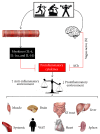Inflammatory Mechanisms Associated with Skeletal Muscle Sequelae after Stroke: Role of Physical Exercise
- PMID: 27647951
- PMCID: PMC5018330
- DOI: 10.1155/2016/3957958
Inflammatory Mechanisms Associated with Skeletal Muscle Sequelae after Stroke: Role of Physical Exercise
Abstract
Inflammatory markers are increased systematically and locally (e.g., skeletal muscle) in stroke patients. Besides being associated with cardiovascular risk factors, proinflammatory cytokines seem to play a key role in muscle atrophy by regulating the pathways involved in this condition. As such, they may cause severe decrease in muscle strength and power, as well as impairment in cardiorespiratory fitness. On the other hand, physical exercise (PE) has been widely suggested as a powerful tool for treating stroke patients, since PE is able to regenerate, even if partially, physical and cognitive functions. However, the mechanisms underlying the beneficial effects of physical exercise in poststroke patients remain poorly understood. Thus, in this study we analyze the candidate mechanisms associated with muscle atrophy in stroke patients, as well as the modulatory effect of inflammation in this condition. Later, we suggest the two strongest anti-inflammatory candidate mechanisms, myokines and the cholinergic anti-inflammatory pathway, which may be activated by physical exercise and may contribute to a decrease in proinflammatory markers of poststroke patients.
Figures



Similar articles
-
Resistance exercise with anti-inflammatory foods attenuates skeletal muscle atrophy induced by chronic inflammation.J Appl Physiol (1985). 2020 Jan 1;128(1):197-211. doi: 10.1152/japplphysiol.00585.2019. Epub 2019 Dec 5. J Appl Physiol (1985). 2020. PMID: 31804892
-
Skeletal muscle changes after hemiparetic stroke and potential beneficial effects of exercise intervention strategies.J Rehabil Res Dev. 2008;45(2):261-72. doi: 10.1682/jrrd.2007.02.0040. J Rehabil Res Dev. 2008. PMID: 18566944 Free PMC article. Review.
-
Exercise and Muscle Atrophy.Adv Exp Med Biol. 2020;1228:255-267. doi: 10.1007/978-981-15-1792-1_17. Adv Exp Med Biol. 2020. PMID: 32342463 Review.
-
Combined Aerobic and Resistance Training for Cardiorespiratory Fitness, Muscle Strength, and Walking Capacity after Stroke: A Systematic Review and Meta-Analysis.J Stroke Cerebrovasc Dis. 2020 Jan;29(1):104498. doi: 10.1016/j.jstrokecerebrovasdis.2019.104498. Epub 2019 Nov 13. J Stroke Cerebrovasc Dis. 2020. PMID: 31732460
-
An Exercise Mimetic Approach to Reduce Poststroke Deconditioning and Enhance Stroke Recovery.Neurorehabil Neural Repair. 2021 Jun;35(6):471-485. doi: 10.1177/15459683211005019. Epub 2021 Apr 7. Neurorehabil Neural Repair. 2021. PMID: 33825581 Free PMC article.
Cited by
-
Inflammatory Stress Effects on Health and Function After Spinal Cord Injury.Top Spinal Cord Inj Rehabil. 2017 Summer;23(3):207-217. doi: 10.1310/sci2303-207. Top Spinal Cord Inj Rehabil. 2017. PMID: 29339896 Free PMC article. Review.
-
Respiratory issues in patients with multiple sclerosis as a risk factor during SARS-CoV-2 infection: a potential role for exercise.Mol Cell Biochem. 2023 Jul;478(7):1533-1559. doi: 10.1007/s11010-022-04610-1. Epub 2022 Nov 21. Mol Cell Biochem. 2023. PMID: 36411399 Free PMC article. Review.
-
Dynamic Resistance Training Improves Cardiac Autonomic Modulation and Oxidative Stress Parameters in Chronic Stroke Survivors: A Randomized Controlled Trial.Oxid Med Cell Longev. 2019 Nov 20;2019:5382843. doi: 10.1155/2019/5382843. eCollection 2019. Oxid Med Cell Longev. 2019. PMID: 31827679 Free PMC article. Clinical Trial.
-
Muscle power-related parameters in middle-aged and older Brazilian women: a cross-sectional study.Sci Rep. 2023 Aug 14;13(1):13186. doi: 10.1038/s41598-023-39182-7. Sci Rep. 2023. PMID: 37580323 Free PMC article.
-
Demethylation and derepression of genomic retroelements in the skeletal muscles of aged mice.Aging Cell. 2019 Dec;18(6):e13042. doi: 10.1111/acel.13042. Epub 2019 Sep 27. Aging Cell. 2019. PMID: 31560164 Free PMC article.
References
MeSH terms
Substances
LinkOut - more resources
Full Text Sources
Other Literature Sources
Medical
Research Materials

